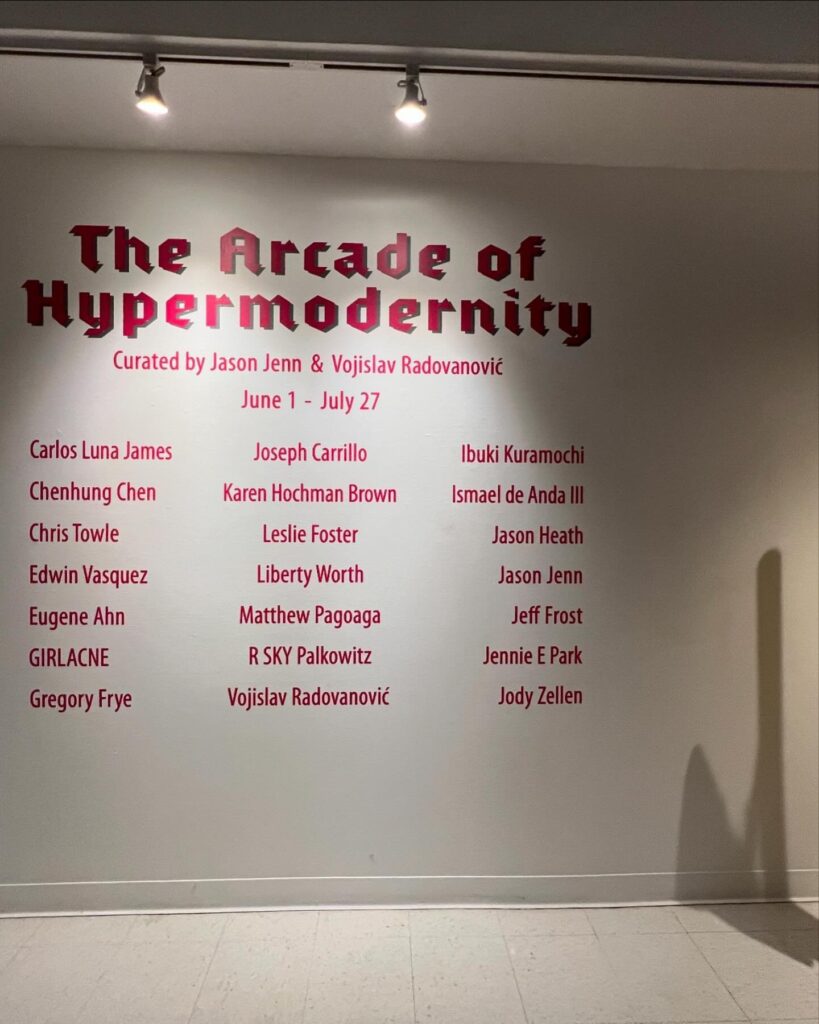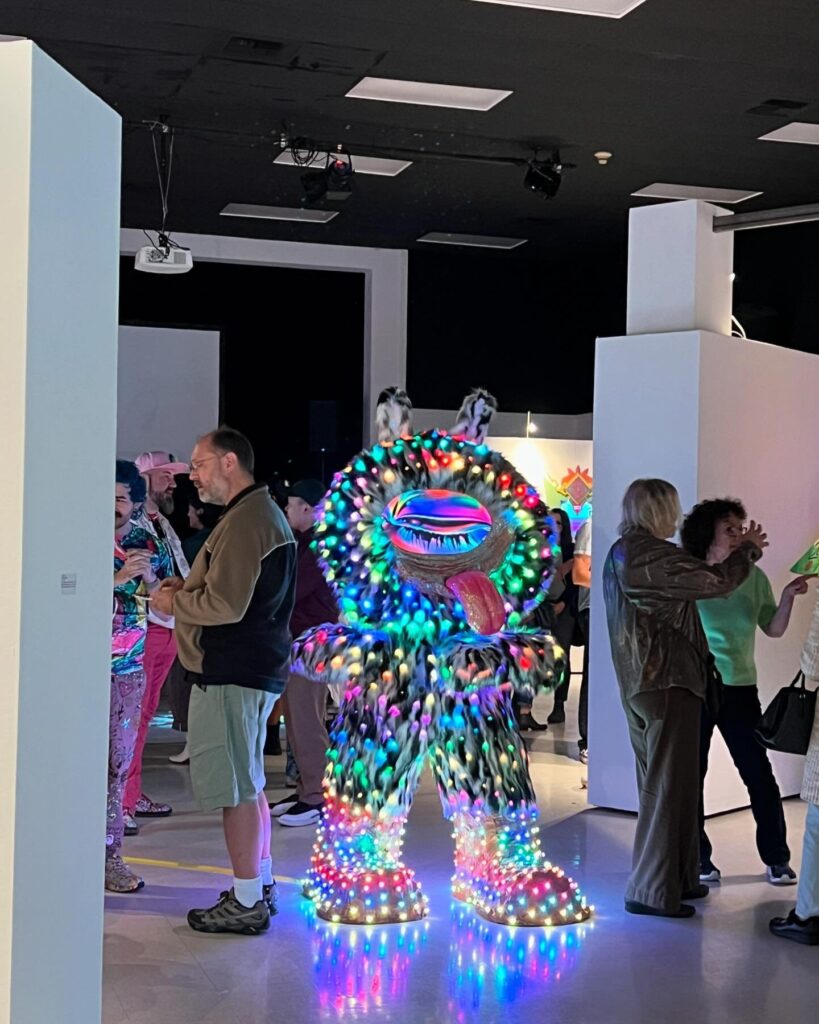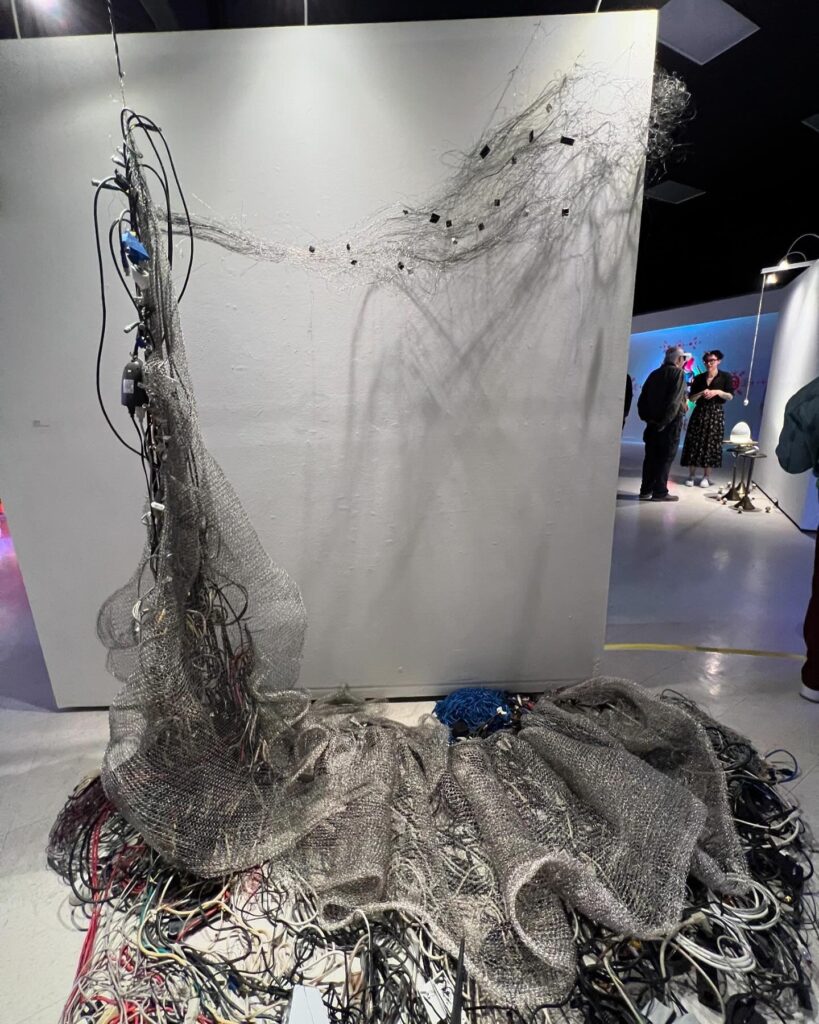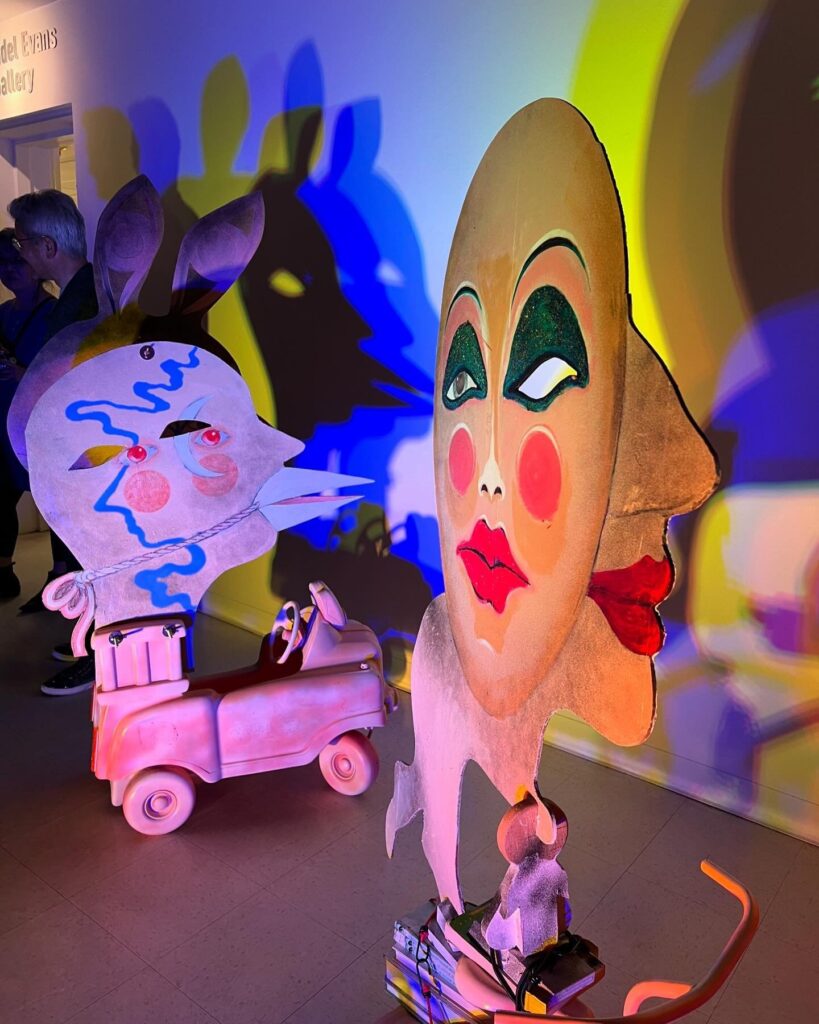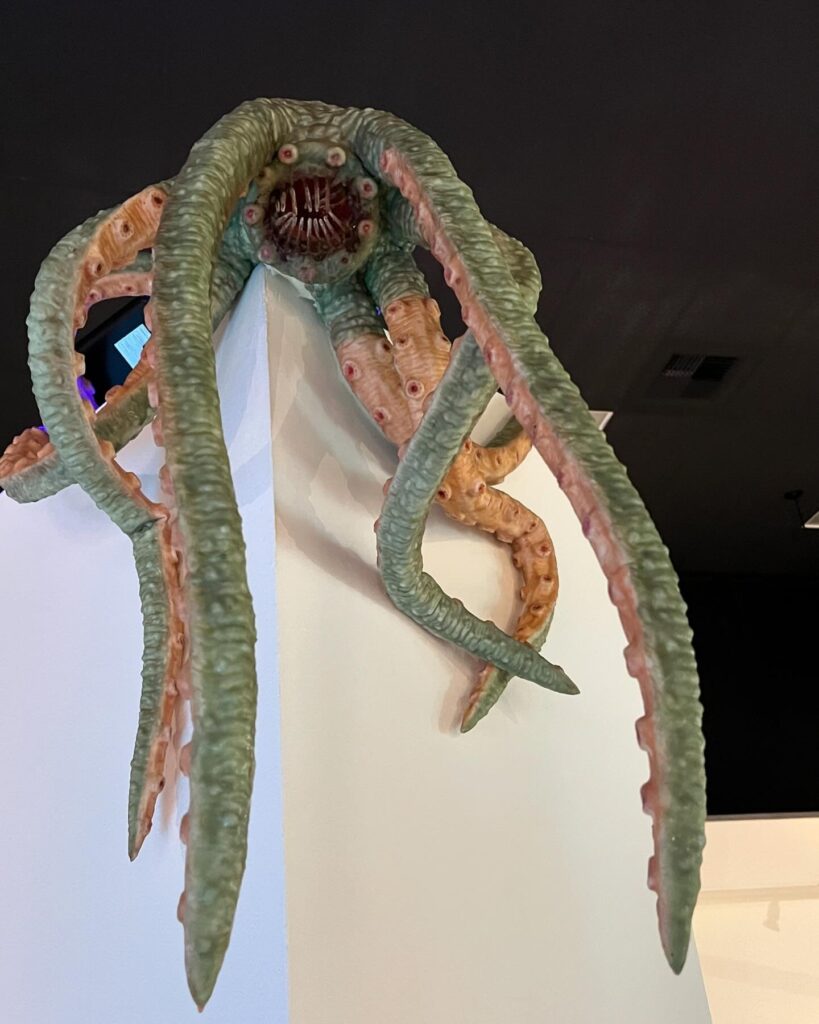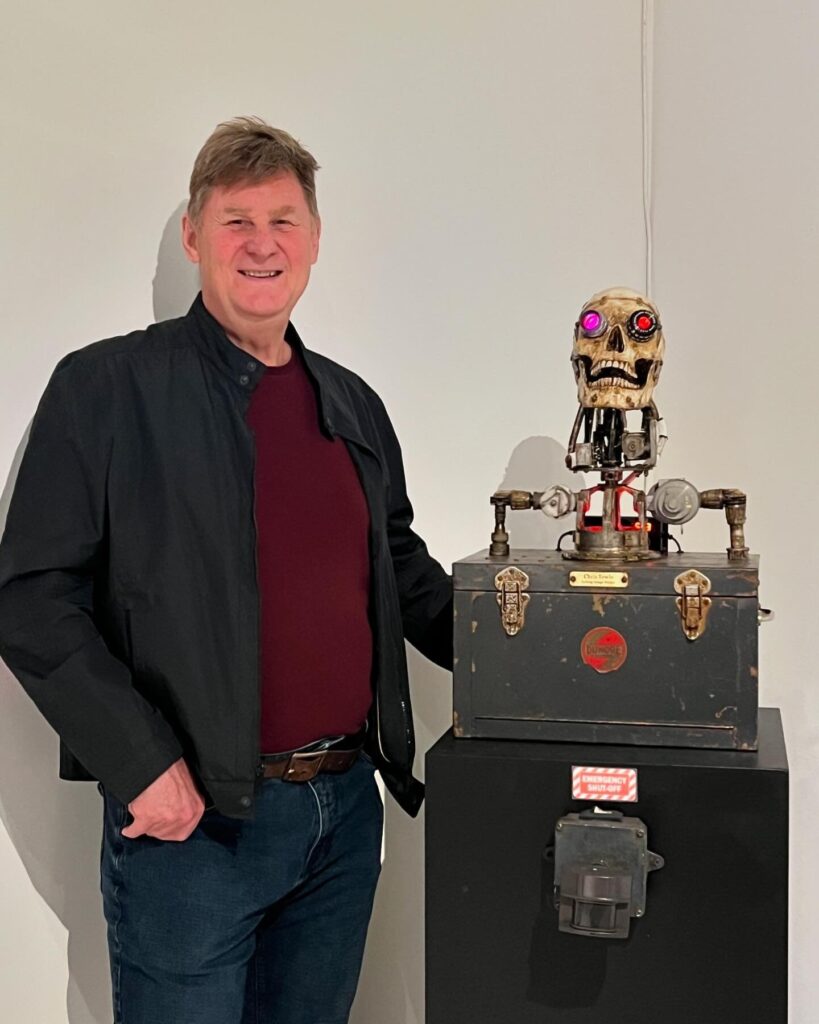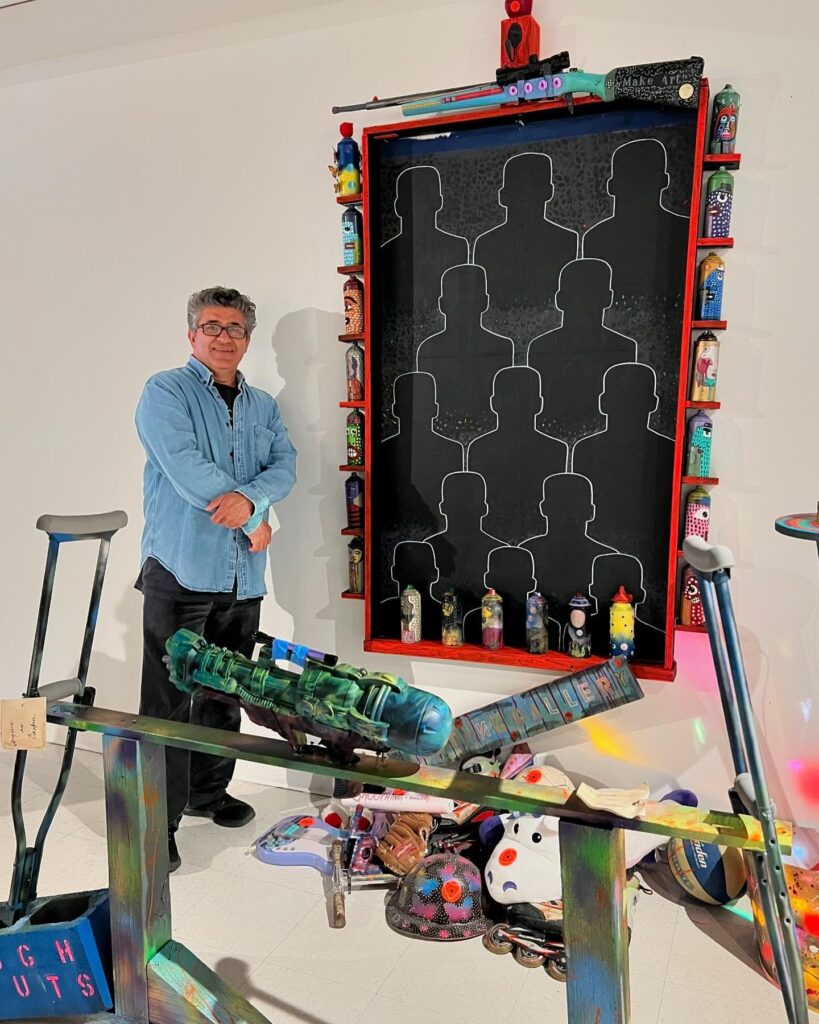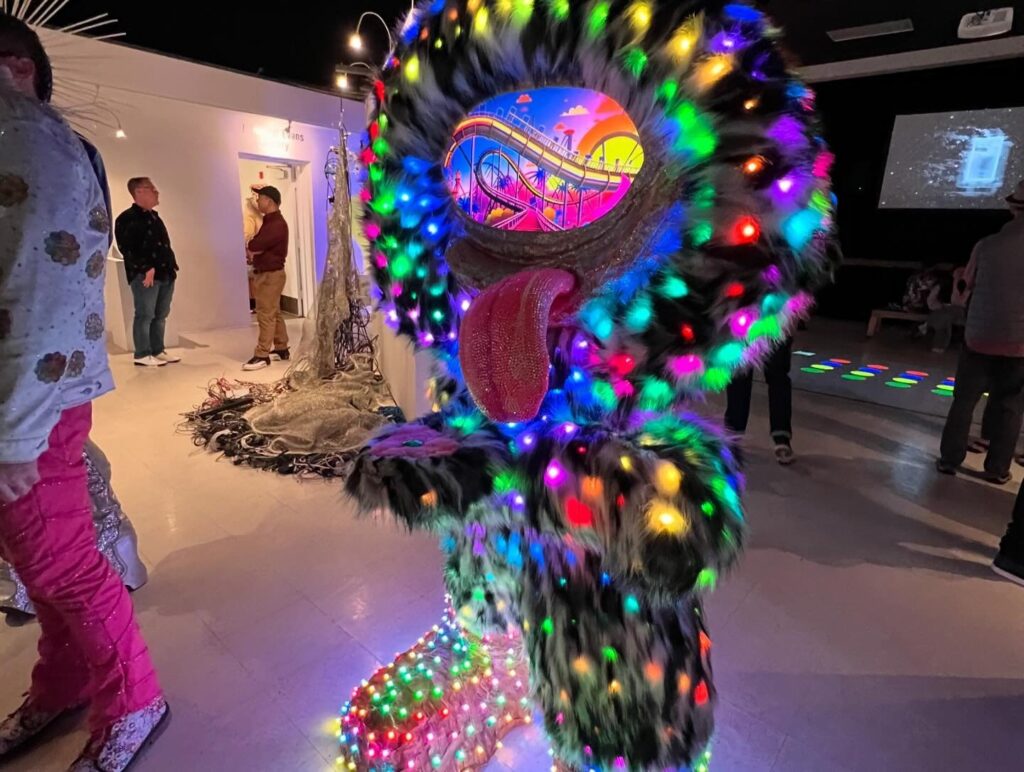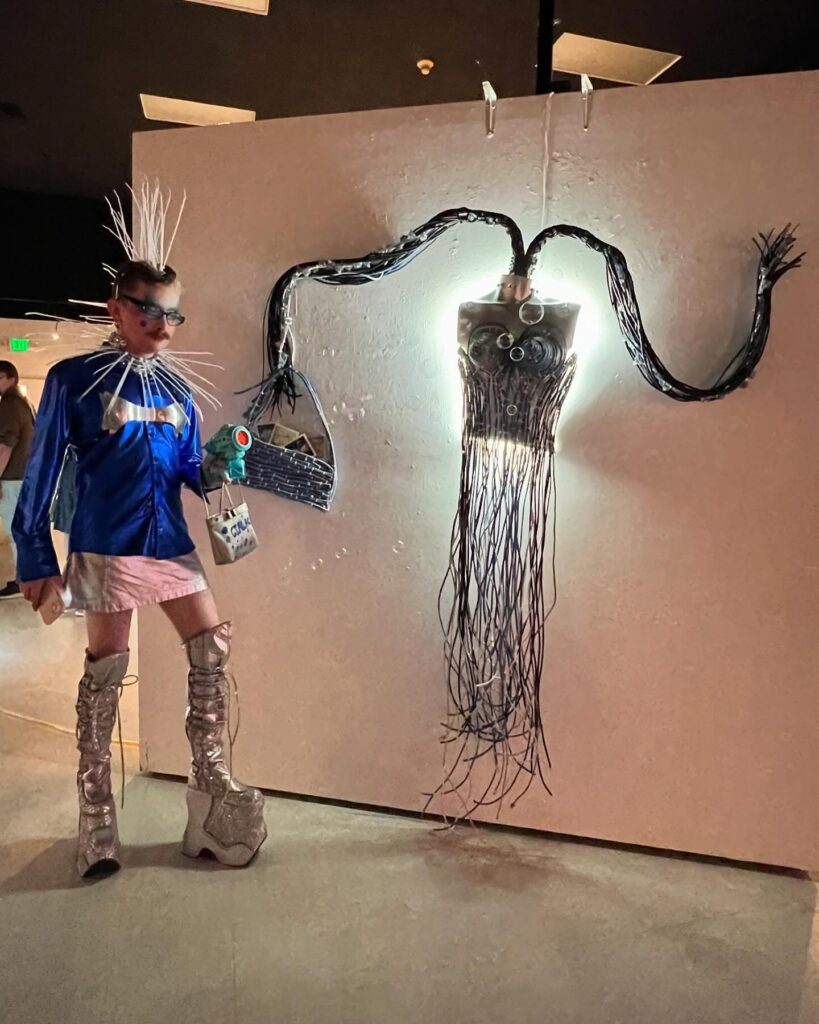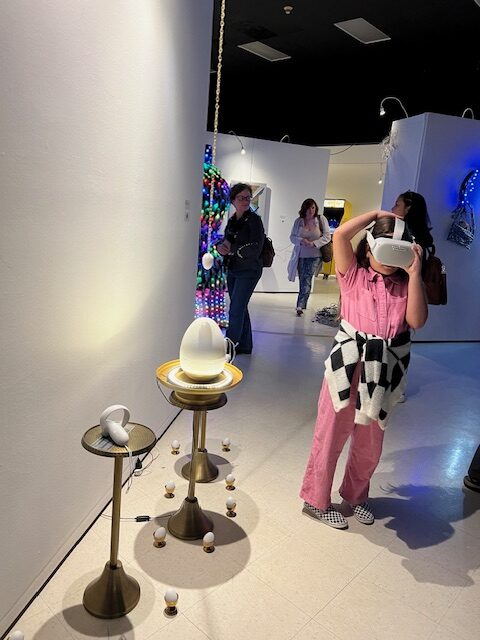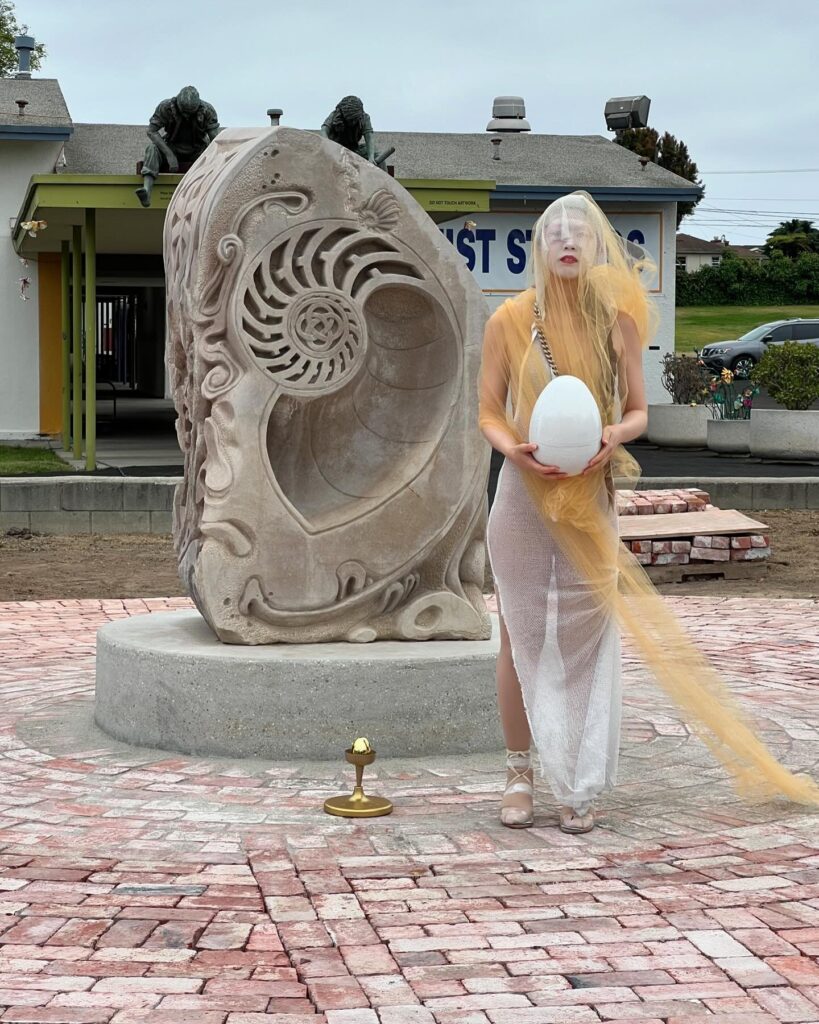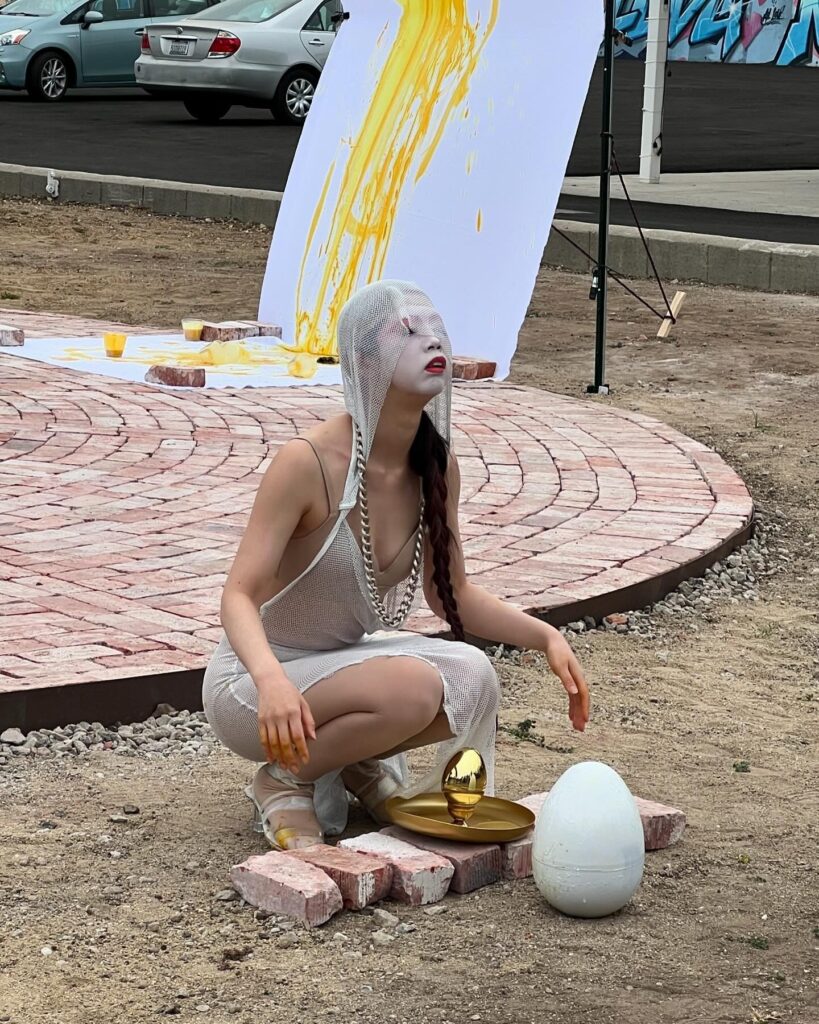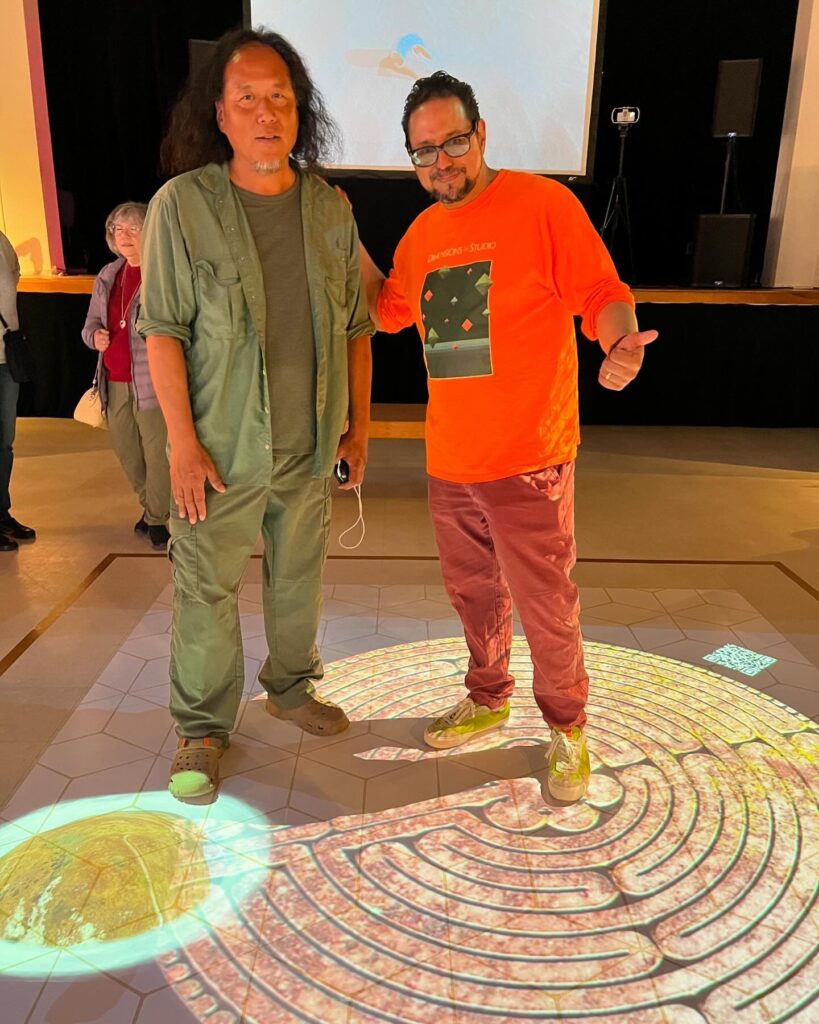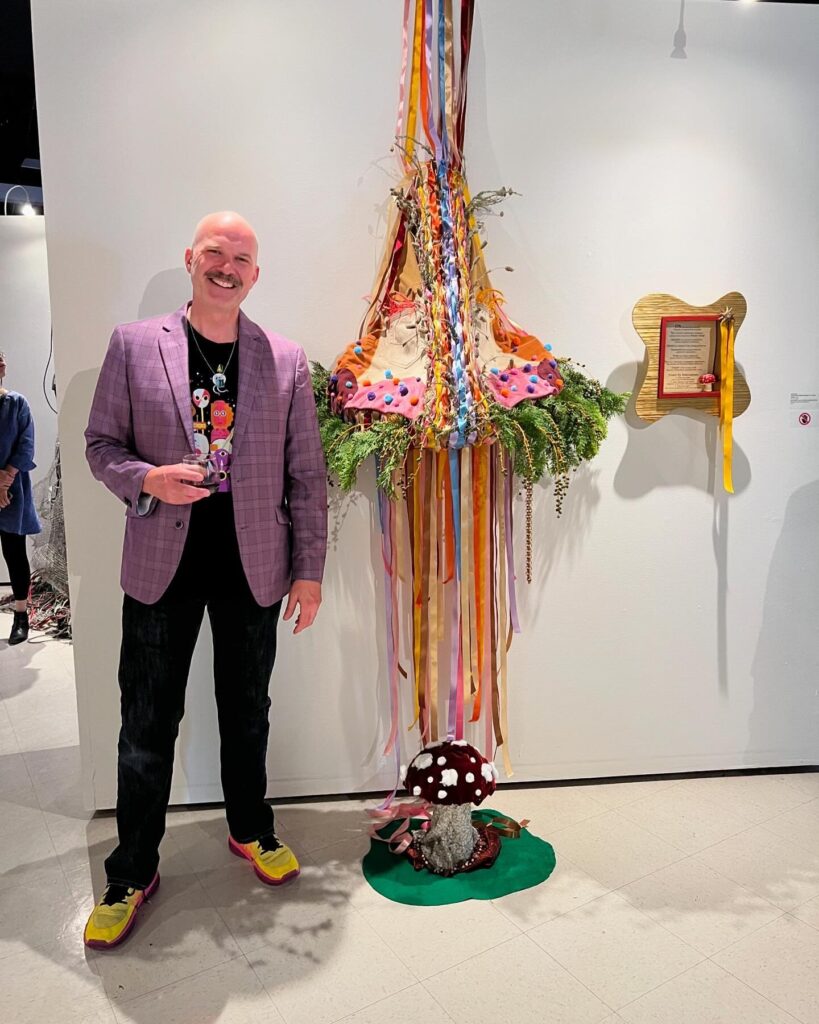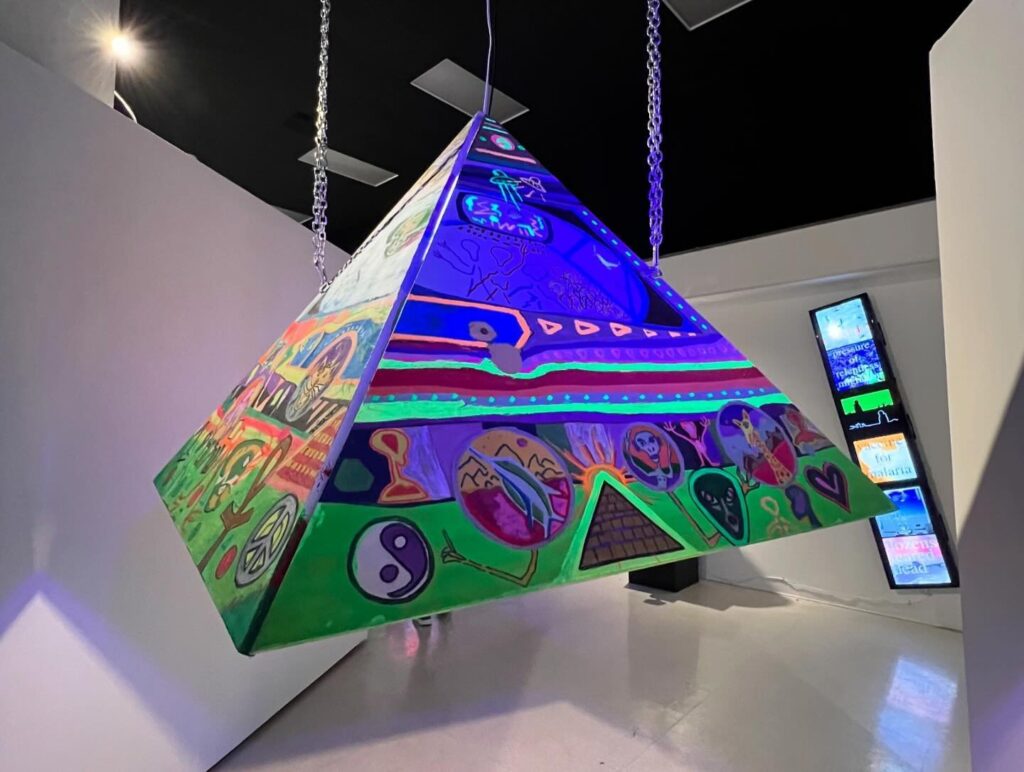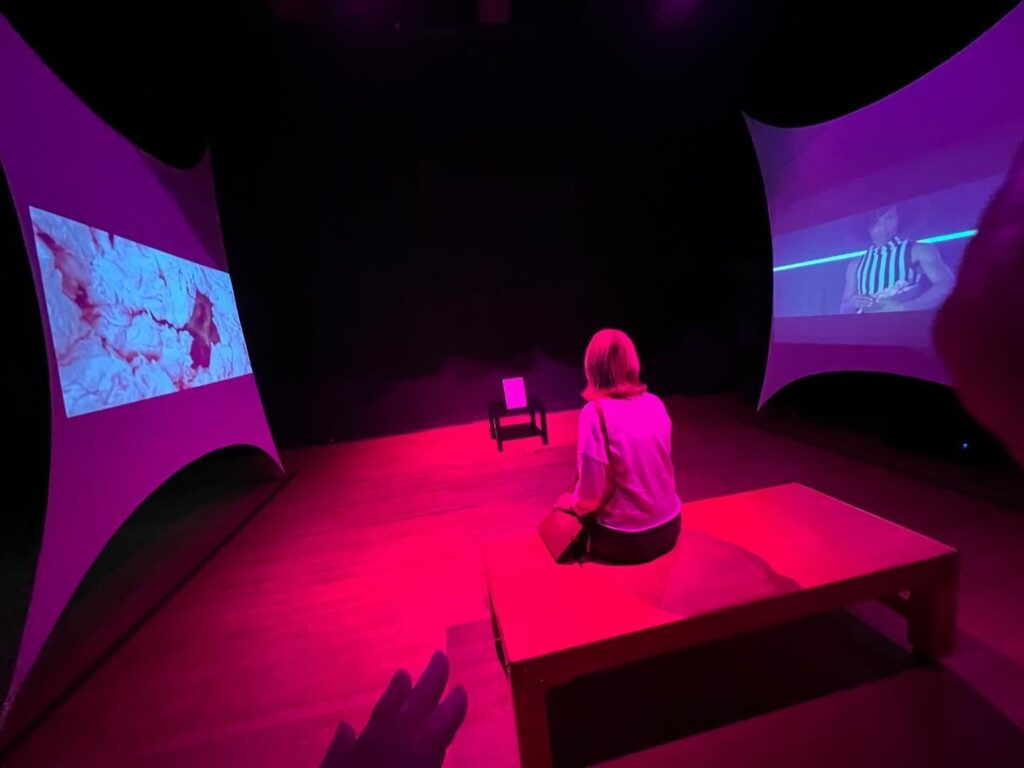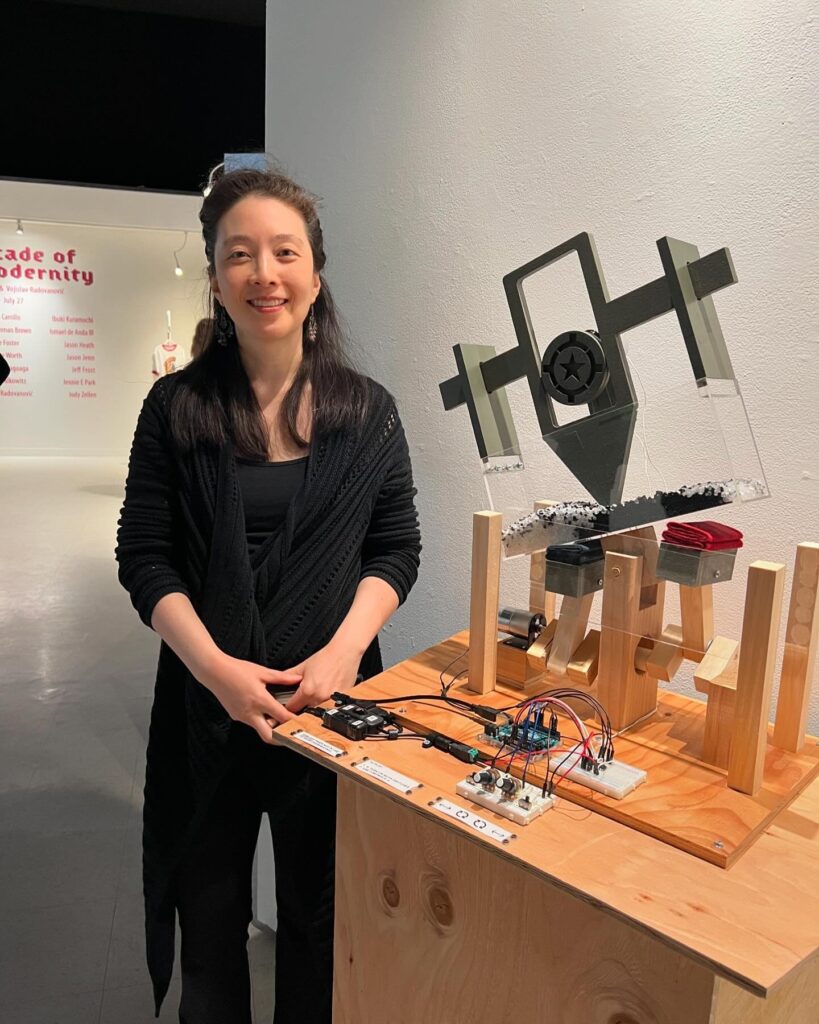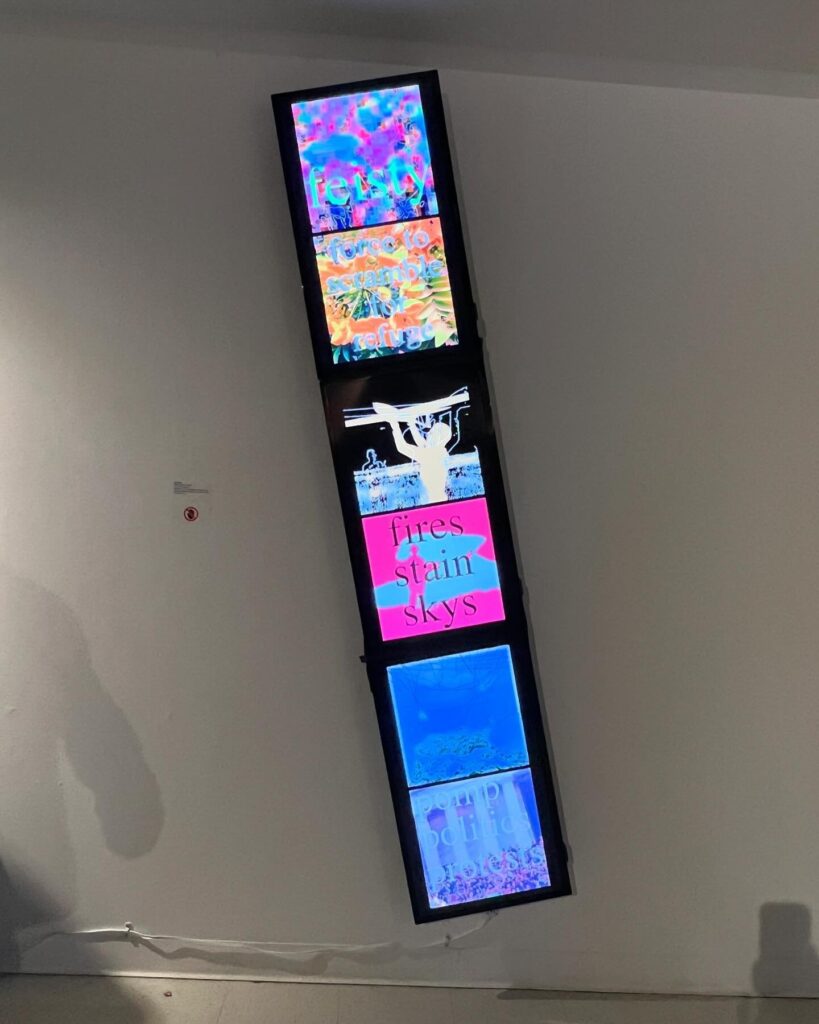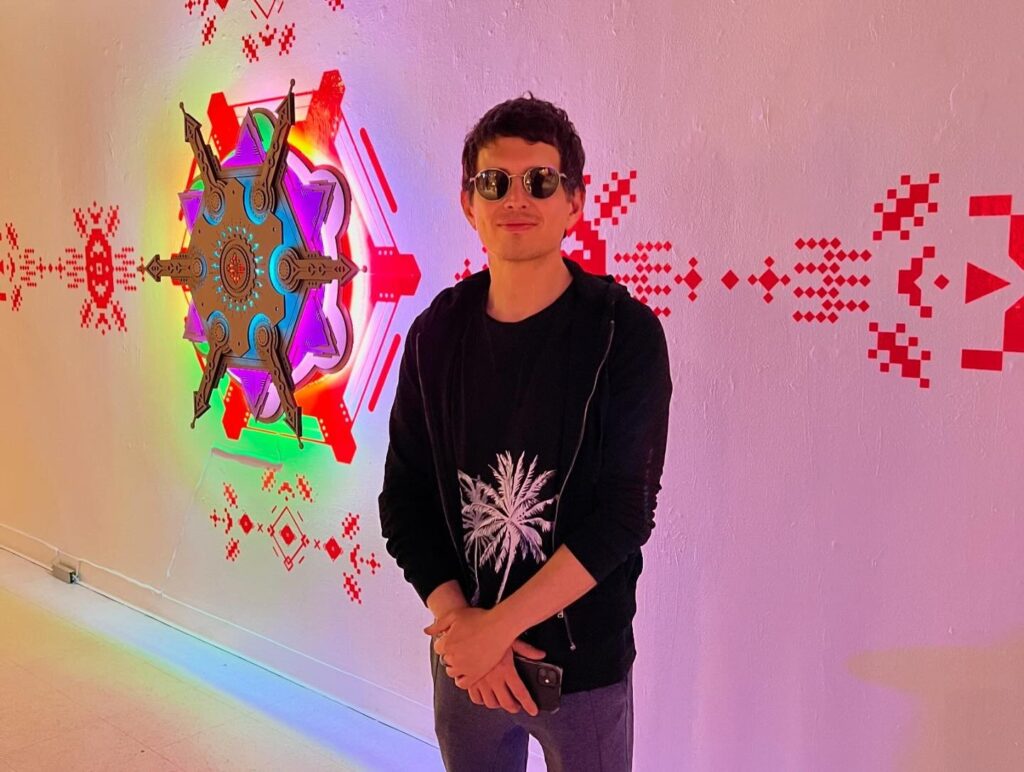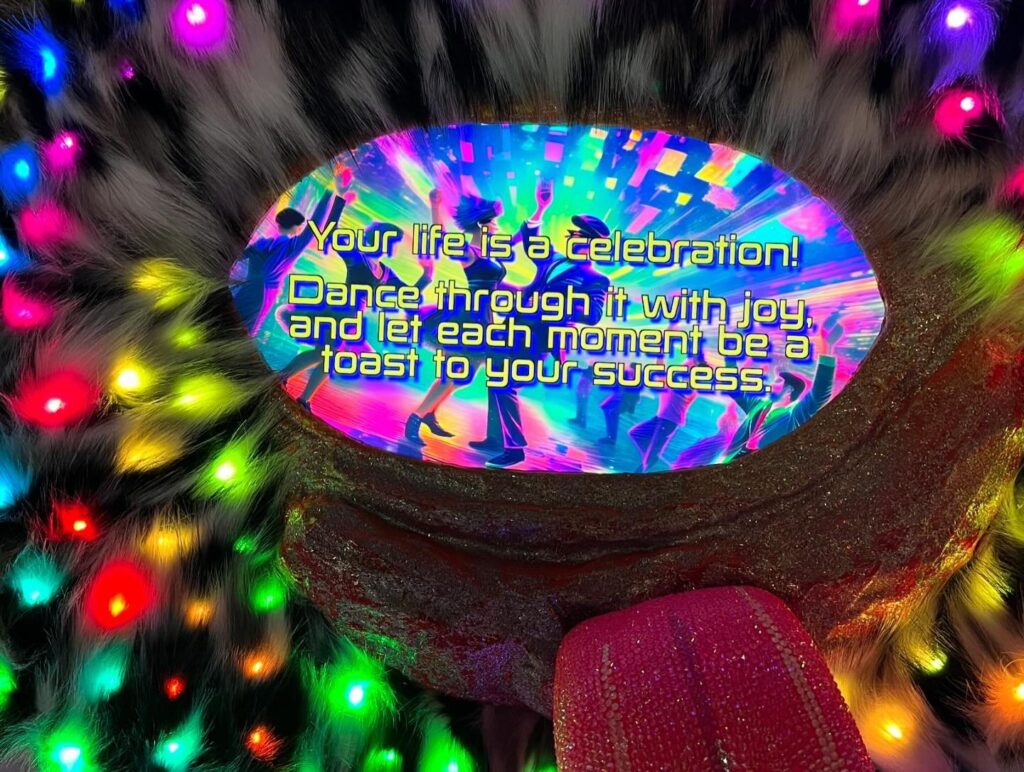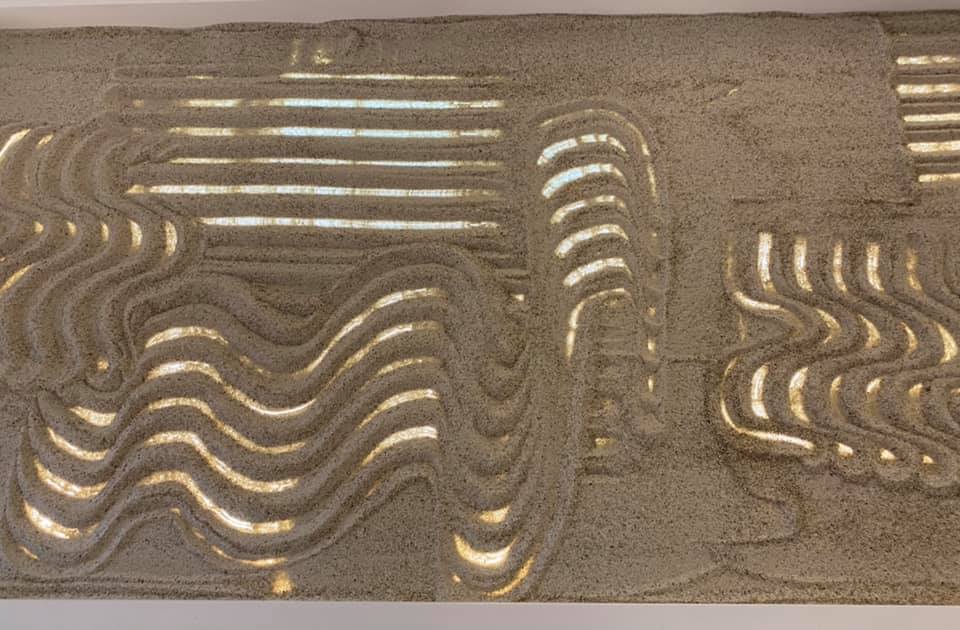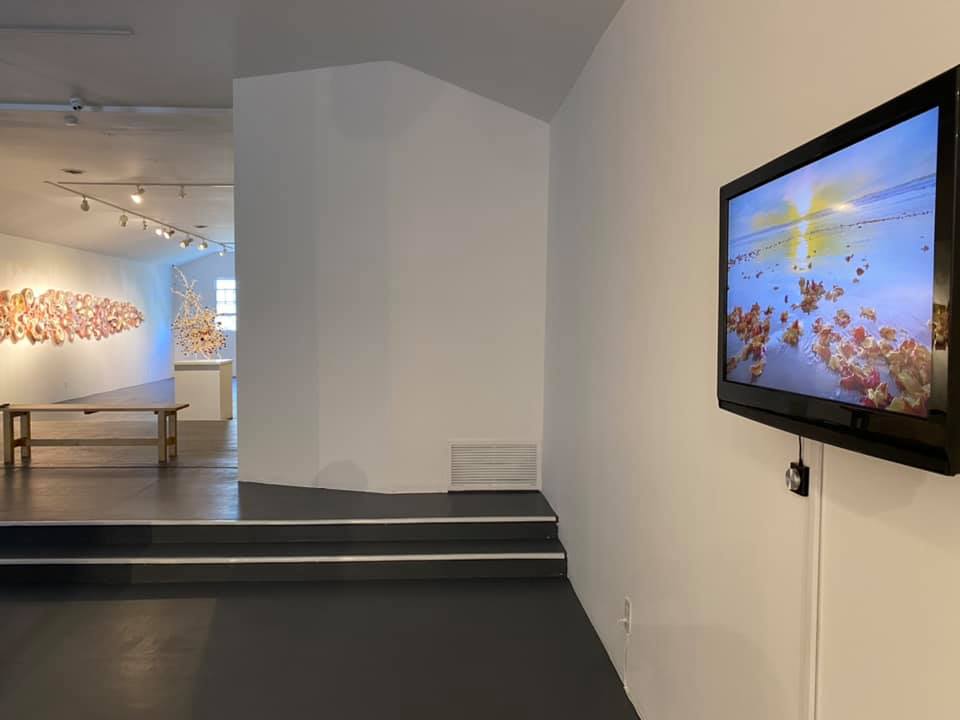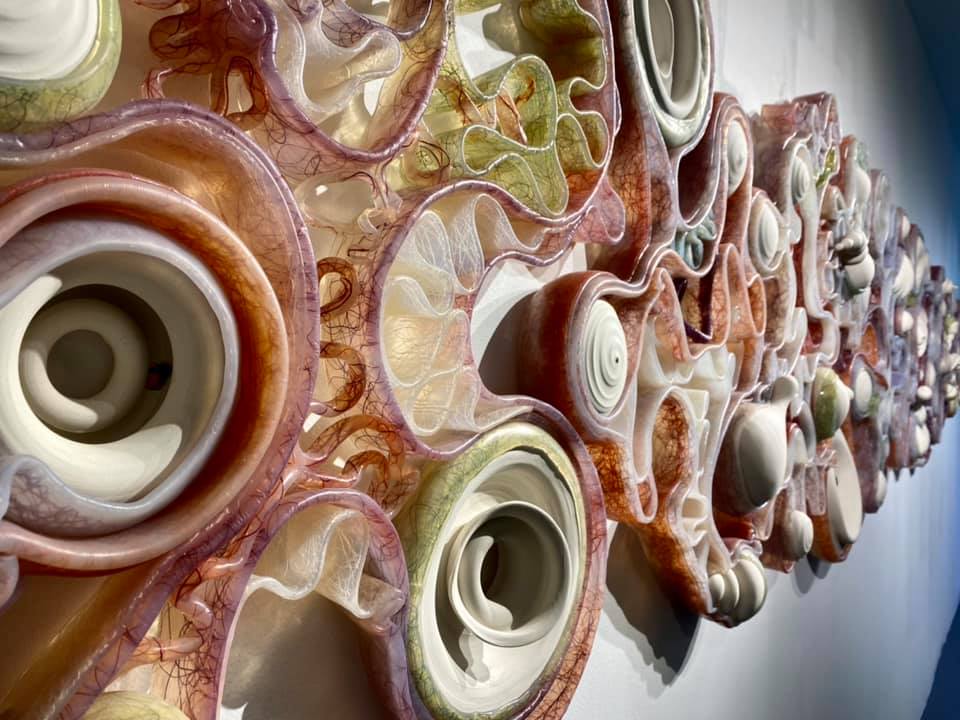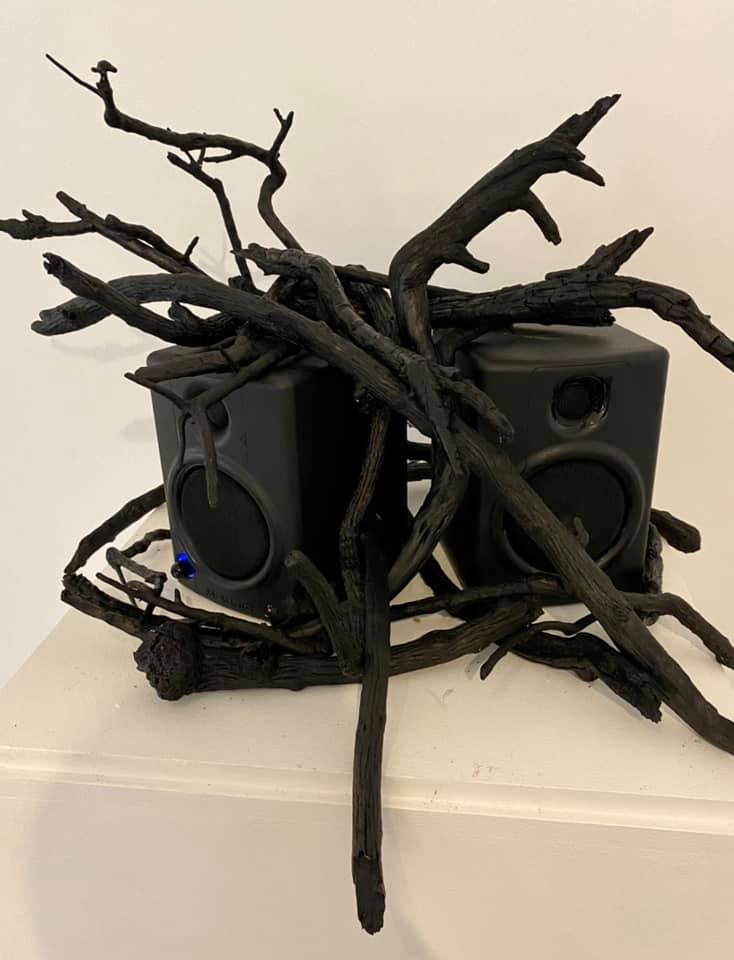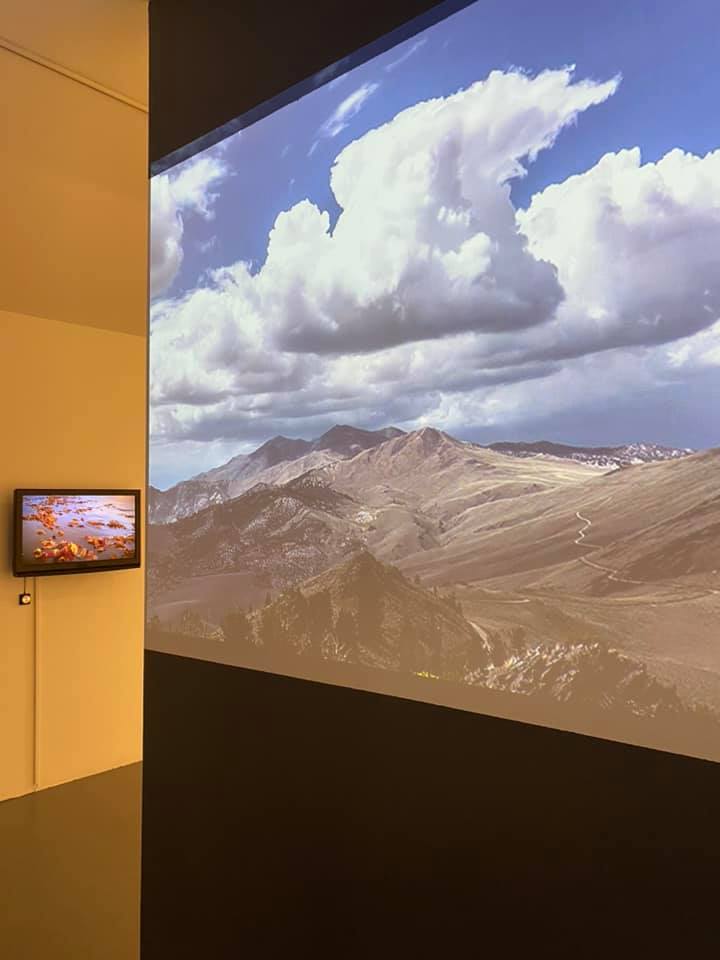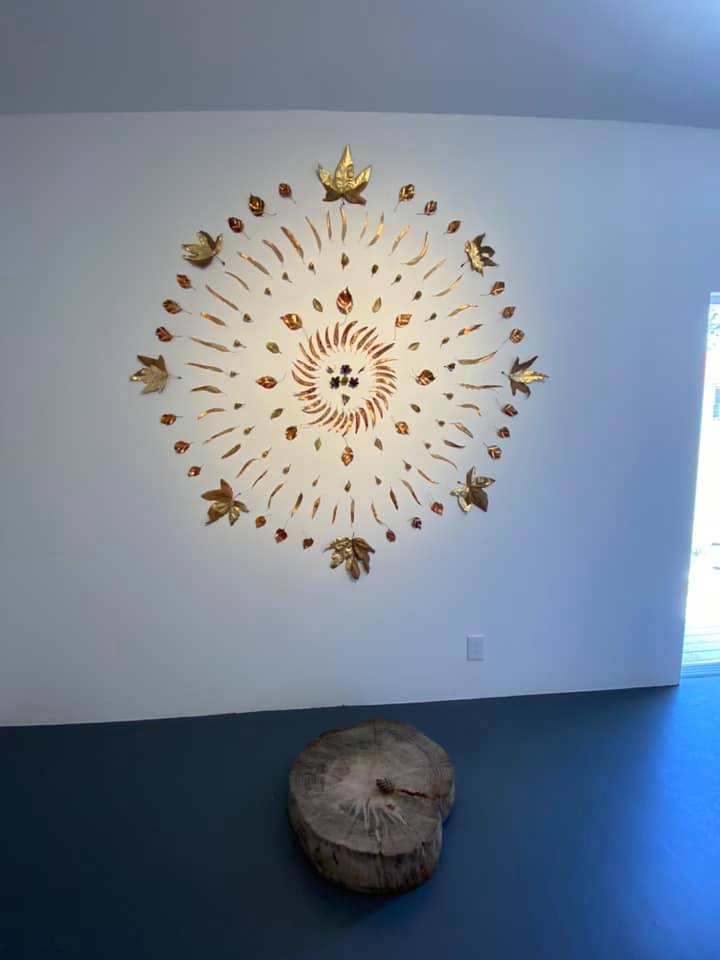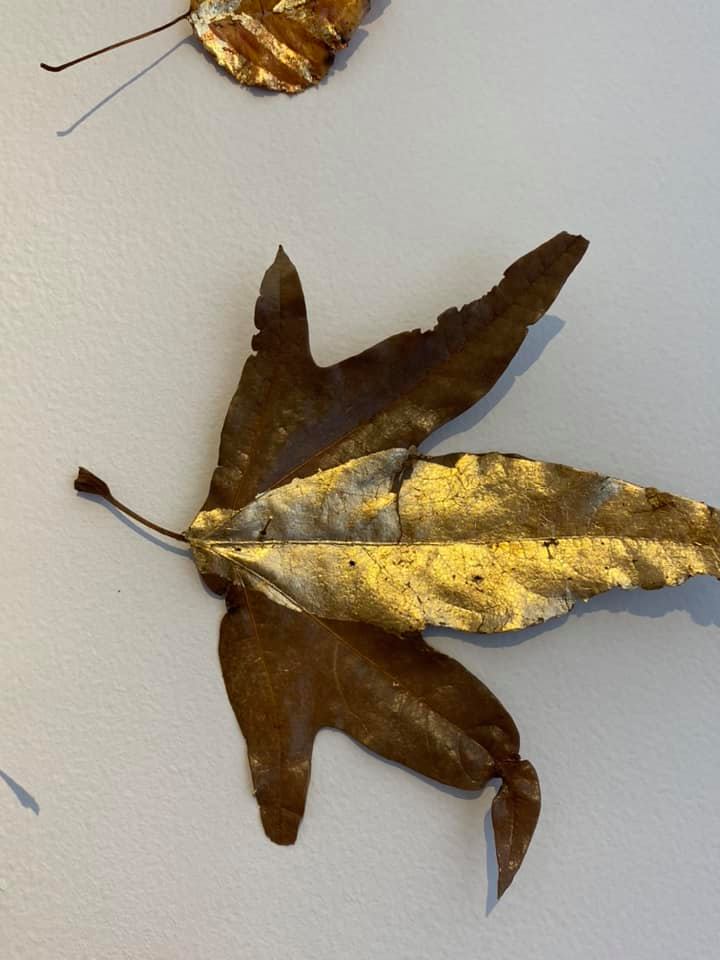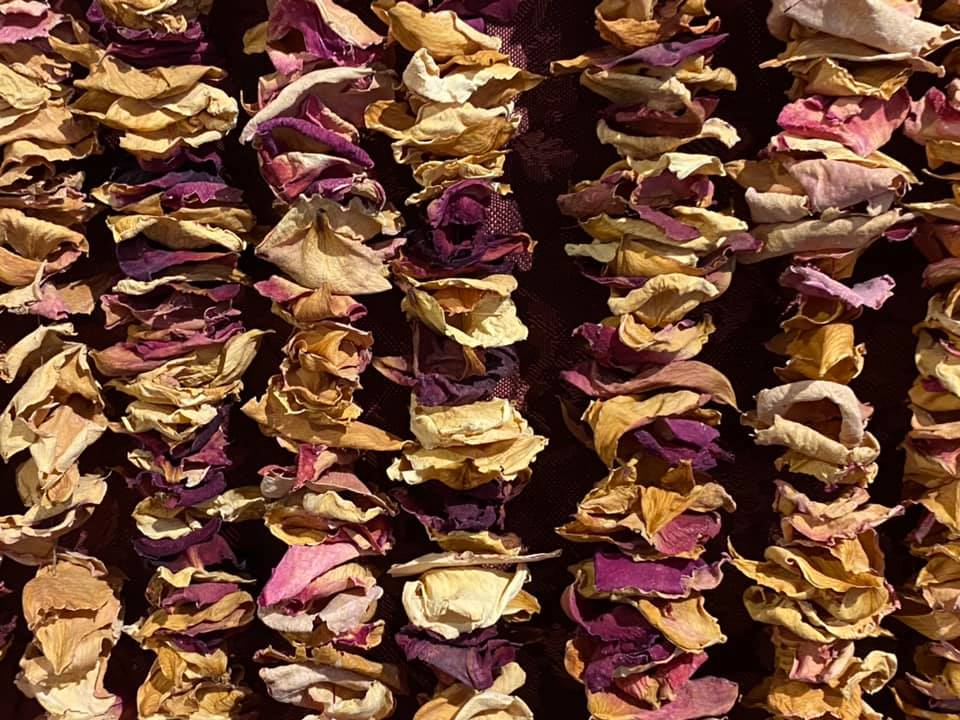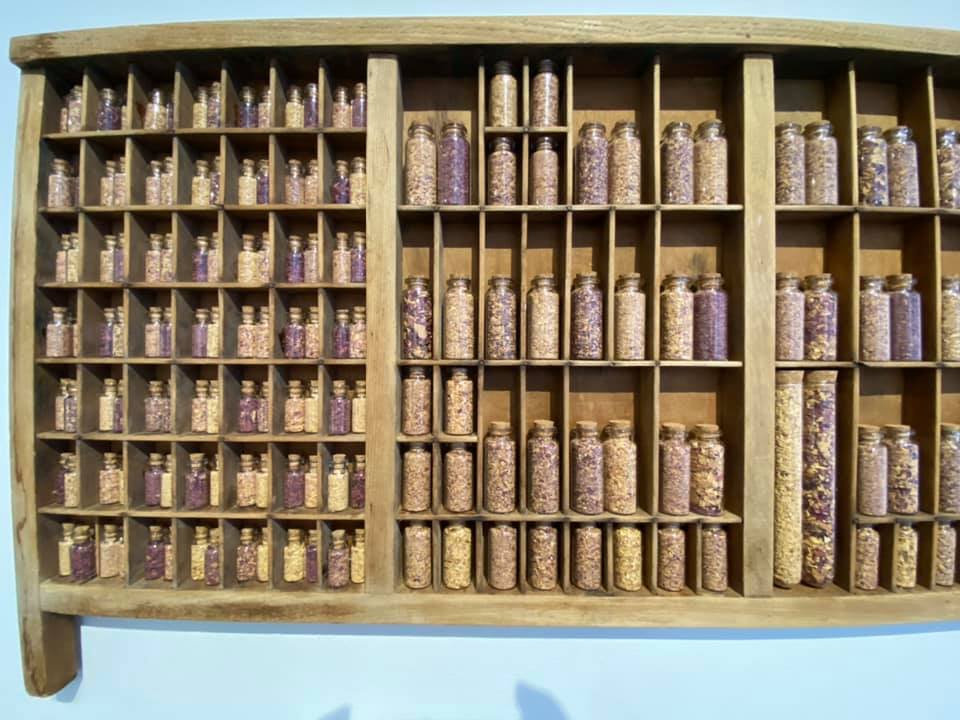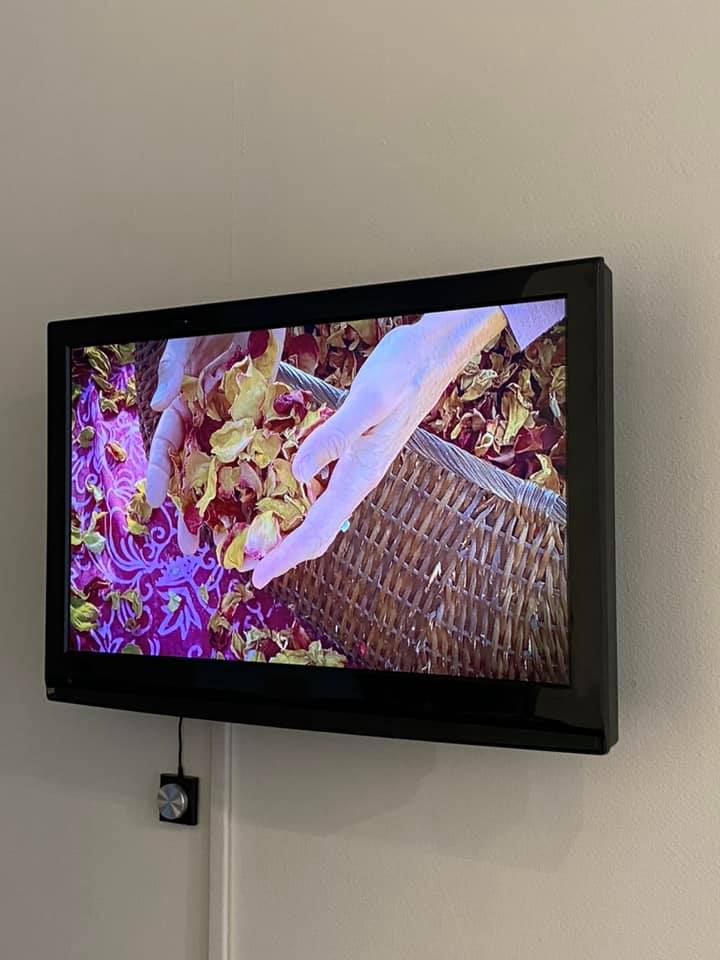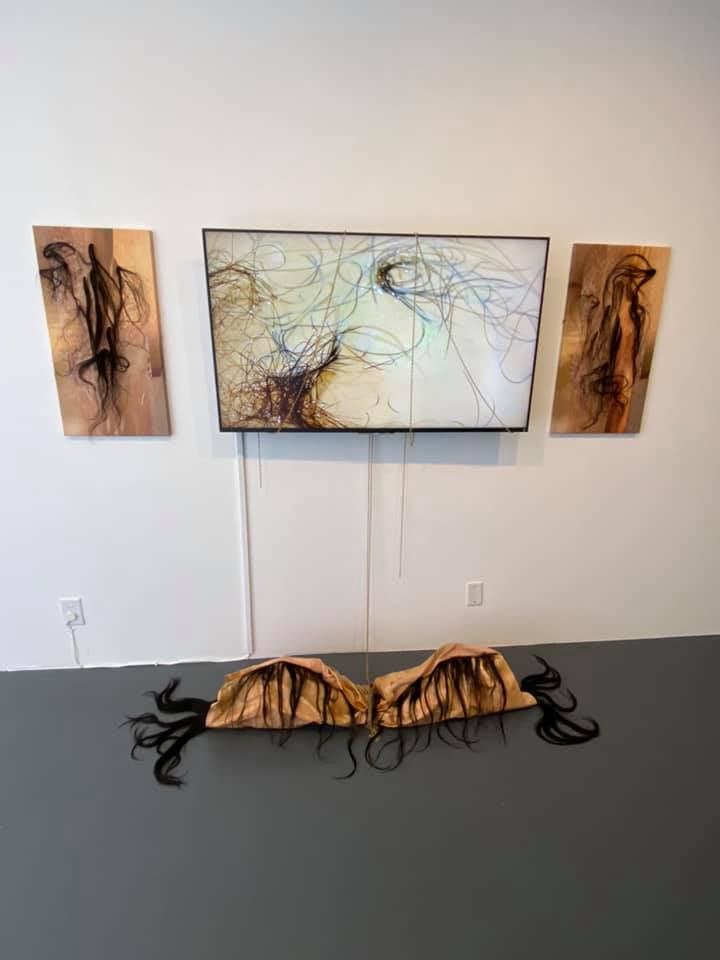“Oh Sandy, the aurora is risin’ behind us/ This pier lights our carnival life on the water…” – Bruce Springsteen
Now at Studio Channel Islands Art Center in Camarillo through, July 27th, curators Jason Jenn and Vojislav Radovanovic create a new kind of carnival life, one that offers its own bright aurora, an interactive world that morphs technology into magic and the rush of modern life and angst into a spiritual and sensual experience.
Exhibiting artists CARLOS LUNA JAMES, CHENHUNG CHEN, CHRIS TOWLE, EDWIN VASQUEZ, EUGENE AHN, GIRLACN, GREGORY FRYE, IBUKI KURAMOCHI, ISMAEL DE ANDA III, JASON HEATH, JASON JENN, JEFF FROST, JENNIE E PARK, JODY ZELLEN, JOSEPH CARRILLO, KAREN HOCHMAN BROWN, LESLIE FOSTER, LIBERTY WORTH, MATTHEW PAGOAGA, R SKY PALKOWITZ, and VOJISLAV RADOVANOVIĆ each shape a miraculous exhibition that invites viewers to partake of a literal art arcade, touching, playing, dancing, and yes, even inhaling the scent of the art.
It’s a pure wow of an exhibition, one that vibrates with energy, a passion for perfromance, romance, the ridiculous, and the sublime. Just as I struggled to decide where to start when wandering through this treasure trove of an exhibition, I also struggle now with how best to describe an experience that is meant to be – experienced.
The curators aptly describe the show as a “vibrant playground of ideas, focusing on the intersection of art, technology, and imagination….it explores the limits of human capability and what is now possible and in a state of major change within this new era of life globally connected online, and the evolution of artificial intelligence.”
And does it ever explore. Equal parts fantasy and futuristic window, the show is visually dazzling but also robustly meaningful. What does it mean to be human? To feel, enjoy, experience? What does it mean to think without being told what to think or how to behave? What does it mean to feel one’s humanity without conforming to political or social structures that limit or lie? How will technology change us, how has it already? Where are we going, and where have we been?
It’s a carnival of art, and a circus of ideas. Some works are sculptural, as are Chenhung Chen’s flowering burst of wire and cable and found objects, “Currents.”
Some are sculptural forms that move, changing in multi-colored lights, mixing a traditional toy that evokes a carnival kiddie ride with fantastical portraiture, as does Vojislav Radovanovic’s take on car culture, “Phantom Traffic I (The Collectors), Phantom Traffic II (Library Girl), and Phantom Traffic III (West Coast Vibes).”
There are steampunk extravaganzas that twist and turn from Chris Towle, whose five elaborate and engaging works here include a silicone film prop, “Kraken,” and a crazy cool clockwork-type piece, “Teatime Movement.”
Edwin Vasquez offers an interactive, mixed media “Shooting Range” that also serves as a trenchant commentary on American gun fetishism.
Gregory Frye’s dazzling fiber optics and mixed media work, a freestanding fortune-telling creature called “Frank Fortune” seems ready to walk out of the gallery, even as it dazzles the eye and the spirit.
Girlacne’s “Body Électrique” wall art is a sinuous mix of LED, wire, and zip ties that undulates with light and shadow.
Ibuki Kuramochi’s ” Eggscapes” gives viewers a mystical VR metaverse to plunge inside – and then rehatch from within.
At the June 1st opening, we were also able to view a stunning performance art and dance from Kuramochi, performed outdoors to a rapt audience.
Her sense of visual poetry embodied themes of birth, rebirth, loss, and revival, all relevant to the exhibition itself.
Presenting a terrific, riveting series of altnerating images, Ismael de Anda III & Eugene Ahn use video projection, AR, and a vinyl dance floor to spin their “Dancing Wu-Li Masters.”
Jason Jenn’s lush, fecund “Ye Ol’ Factory Station (Homage to Sir Joseph Paxton),” includes elements scented with essential oils that conjur up forests and fantasies.
Karen Hochman Brown’s “Circuitry” offers a geometric display of digital frames and cords that resemble luminous eyes.
SKY Palkowitz’ “ALIEN ARCADE UFP Unidentified Flying Pyramid – Classified: Pleiades Starship 444 – Codename: Elohim,” invites viewers to stand beneath this mysterious shape, and view its black-lit and transportive interior.
There are mysterious and magical video works from Leslie Foster, and the vivid palette of Jeff Frost…
…a motion-activated low-tech piece from Jennie E. Park…
a thought-provoking digital “film strip” from Jodi Zellen.
Viewers also get to explore Joseph Carrillo’s musically driven “The Arcade Fantasy,” as well as Mathew Pagoaga’s exciting video game-centered, multiple installation “Trust.”
Carlos Luna James superb and transformative “OPTIMUS” AR activation, one of two dynamite pieces the artist has here, is an innovative mind-blower. Take a look below:
And these are by no means every piece on display. Each work and each artist offers something quite wonderful, strange, special, and unique – you will not see these works elsewhere. If you saw the DTLA-recreation of Luna Luna Amusement Park, originally created in Germany by seminal artists of that time, you could easily imagine The Arcade of Hypermodernity as such a revered classic of the future. It’s spectacular, and just a whole lot of fun.
While this exhibition pays tribute to the idea and reality of arcades and midways, it also serves as an homage to this quintessential moment in time, one in which our creativity, our humanity, our playfulness, are all on the verge of great change. There is the expansive possibility of technology, and conversely the dulling of our capacity for connectivity and intimacy through its remoteness. Can we embrace great change without it forever changing us? How much have we changed already, and become hybrids of the human and the inhuman as the price of simply staying alive? How can our creativity, the root from which our humanity springs, still define us?
Walk through this arcade and you’ll find hope, happiness, and as many questions as answers. You’ll find the magic that makes art live and the art that makes the magic. Now go wave a wand, or get on the freeway – whatever works for you – and go see this show. “Frank Fortune” is waiting to tell your future.
Studio Channel Islands Art Center is located at 2222 Ventura Blvd, in Camarillo. For hours, schedule of artist’s talks and other activations, as well as directions, click here.
- Written by Genie Davis; photos by Genie Davis



